ap bio unit 7 review
Types of Selection
Evidence of Evolution
- populations evolves when some members of the population have greater fitness and reproductive success than others
- evidence can be found in extant (living) and extinct (non-living) species:
- molecular evidence: comparison of dna and amino acid sequences (in proteins) from different organisms provides evidence of evolution
- when comparing dna sequence of a gene that is shared by different organisms, the more similar the dna sequence is, the more closely related they are/ the more recently they share a common ancestor
- considered very strong evidence because environmental factors usually do not change an organism’s dna sequence
- morphology: homologous structures, which have common ancestry but different functions, provide evidence of evolution
- structures between different organisms indicated common ancestry and the evidence of evolution
- fossils: transitional fossils show intermediate states between ancestral and modern species
- fossils can be dated by studying the age of rock layers in which they are found or by using radioactive isotopes
- vestigial structures: some organisms have anatomical features that do not serve them any purpose modernly, but may have served the ancestral organism
- humans have a tailbone, which is useless now but may have helped the ancestor of humans climb trees
- convergent evolution: species that line in similar environments may evolve similar adaptations even though they don’t have a recent (or any) common ancestor
- sharks and dolphins are similar in physical appearance, but have no recent common ancestor
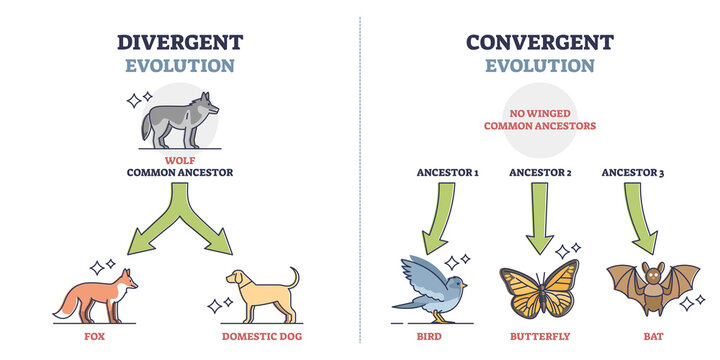
- biogeographical evidence: study of distribution of species contributes evidence to evolution
- species found on islands off the coast of south america are more similar to species found in south america than to north america
- observation of evolution in current species:
- when repeatedly exposed to antibiotics, bacteria develop a resistance to it by evolving
- tumor cells developing resistance to chemotherapy drugs
- pesticide resistance in insects
- evolution of previously unseen viruses and pathogens
- genomic changes in an organism over time
Natural Selection
individuals do not evolve; populations can evolve
differential reproductive success: leads to changes in populations based on favored and unfavored phenotypes
directional, stabilizing, and disruptive, selection all rely on mechanisms of natural selection
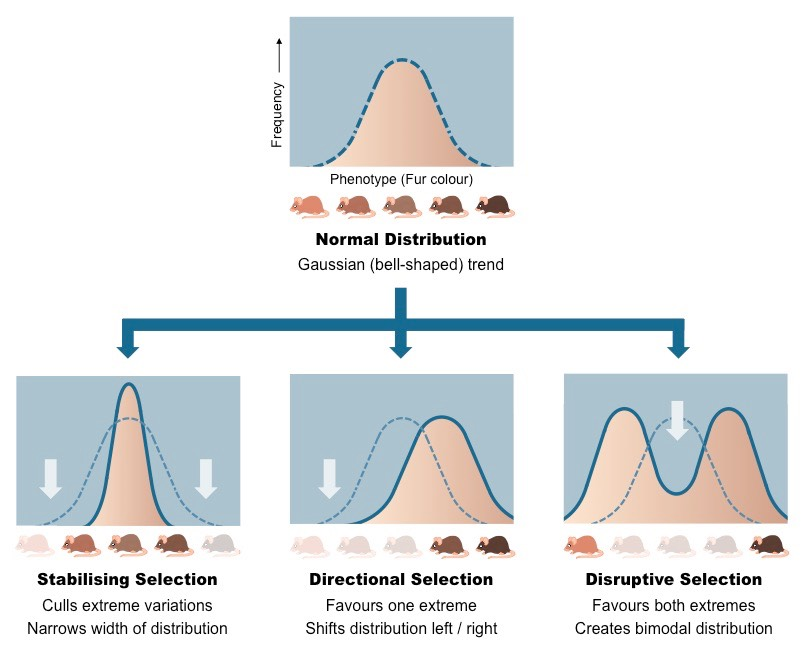
natural selection: mechanism for evolution proposed by charles darwin; core theories of natural selection include:
- variations in populations lead to different phenotypes in members of the population
- competition for resources or predation lead to some members of the population surviving while others do not
- the environment determines which phenotypes are favorable
- individuals with phenotypes that give them a survival advantage are more likely to survive and reproduce (differential reproductive success)
- favorable phenotypes will become more prevalent over time as members of the population without those favorable phenotypes do not survive
Examples of Evolution by Natural Selection
- antibiotic resistance: some bacteria in a population will have genotypes that cause them to be more or less sensitive to the antibiotics; those with less sensitivity to antibiotics have more fitness and reproductive success and therefore will survive and pass on the resistance to the next generation of bacteria
- individual bacteria do not “learn” resistance; as a population, the more favorable trait (resistance) becomes more prevalent as the more sensitive bacteria dies off
- peppered moth in england: peppered moths had either dark wings or light wings; depending on their environment, wing color would make them harder or easier to see, making them less or more easy to be preyed upon; darker moths had the advantage to blend in with darker trees, so lighter moths died off and the darker phenotype became more prevalent in subsequent generations
- when the environment changes, different phenotypes may have the advantage and the changing environment can change the direction of the evolution of the species
Directional Selection
- directional selection: occurs when one end of the range of phenotypes is favored by natural selection, causing the frequency of that phenotype to increase over time
- example: peppered moth example from above
Stabilizing Selection
- stabilizing selection: where the intermediate phenotype is favored and the extreme phenotypes are selected against
- example: clutch size (number of eggs laid by birds during each reproductive cycle)
- too many eggs: there are too many offspring to support and this leads to low reproductive success in the just born generation
- too few eggs: the risk that none of the offspring survives increases
Disruptive Selection
- disruptive selection: where individuals on both extremes of the phenotypic range are favored more than the intermediate phenotype
- example: mice fur color in environment with both very light and very dark elements
- light fur mice: can blend in with light elements
- dark fur mice: can blend in with dark elements
- medium fur mice: cannot blend in with either; become preyed upon more often
Artificial Selection
artificial selection: requires human interference; when humans selectively breed certain plants or animals to make desirable traits more prevalent in a given population
instead of the environment picking, humans select individuals with more favorable phenotypes and promote their rate of survival and reproduction
example: wild cabbage breeding
- farmers bred wild cabbage plants to achieve the perfect cabbage plant with desirable traits such as large in size, resistant to pesticide, etc.
example: crossbreeding domesticated wolves
- cross-breeding domesticated wolves has led to the majority of the domestic dog breeds we have today
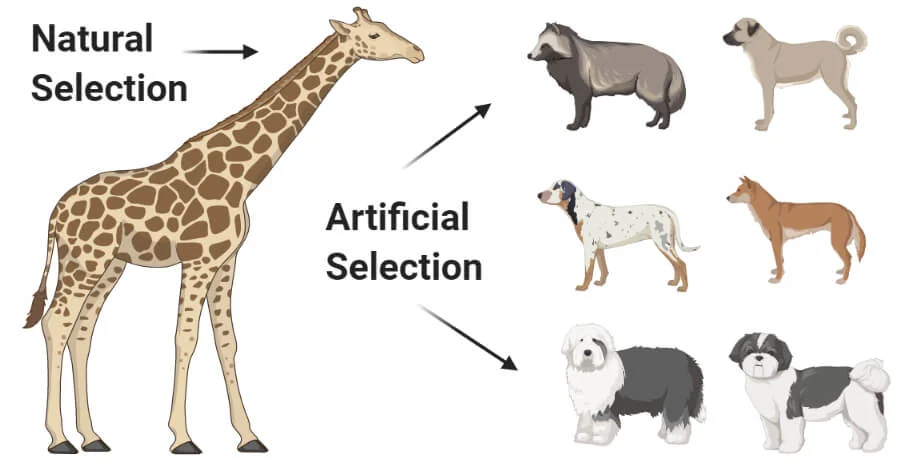
Sexual Selection
- sexual selection: occurs when individuals of a given population have traits that are more likely to attract mates than others; over time individuals (and their characteristics) with the more attractive traits become more prevalent in the population
- mate choice: in nature, it can be determined by perceived fitness of an individual, coat color, mating call, etc.
- example: peacocks
- peacocks feathers attract more mates if they are larger and more colorful, which increases the chance of larger and more colorful offspring being produced in a given population
- in intrasexual selection: members of one sex compete for mates from the other sex; this may involve asserting dominance to ward off competitors
Population Genetics
Population Genetics and Genetic Drift
- population genetics: the study of genetic variation within a given population and the processes that cause changes to the allele frequencies within the population
- three major processes that drive changes in allele frequencies:
- natural selection: organisms that are more adapted to their environment are more likely to survive and pass on the genes that aided their success
- gene flow: the transfer of alleles from one population to another; can be caused by the migration individuals into a population
- if the individuals carry different alleles than the receiving population, the allele frequency of the receiving population will change
- in plants: gene flow can occur by transfer of pollen (by wind or animals) into new plant populations
- genetic drift: the random loss of alleles in a population; more likely to occur in smaller populations; results in loss of genetic diversity
- example: an allele is found in 10% of a population; in a population with 1000 people, it is more likely that at least 1 of the 100 individuals making up that 10% can pass the trait on; in a population with only 10 individuals, it is less likely that the 1 individual making up that 10% can pass the trait on
Bottleneck Effect
bottleneck effect: possible cause of genetic drift; occurs when the size of a population is greatly reduced for one or more generations; can be caused by:
- natural disasters: flooding, forest fires, volcanic eruptions, etc.
- man-made events: overhunting, rapid habitat destruction, etc.
population is smaller after bottleneck effect, leading to smaller chance of having genetic diversity in the population due to loss of alleles
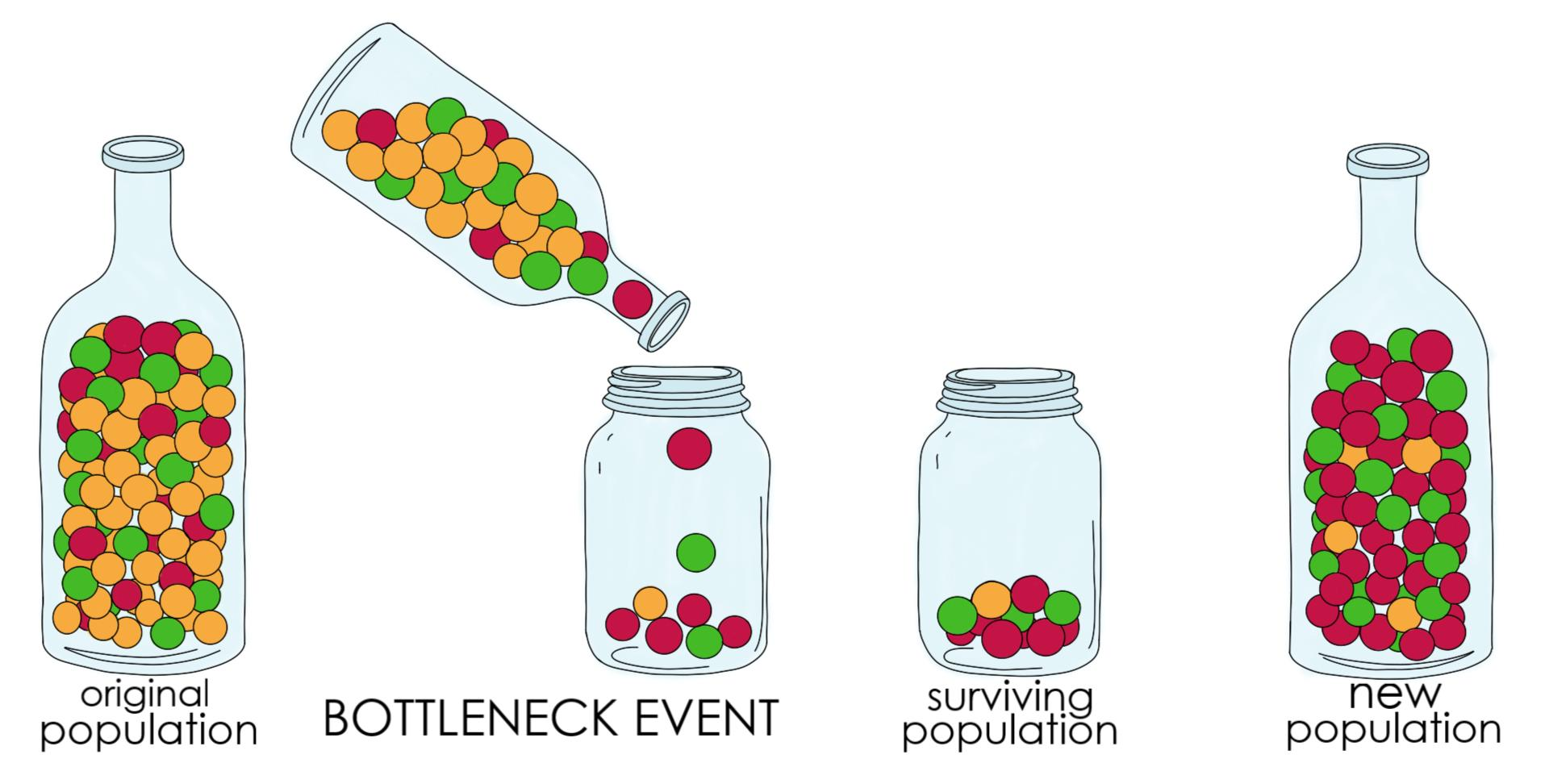
Founder Effect
founder effect: another cause of genetic drift; occurs when a few members of a large population start a new population (usually somewhere else as the populations wee separated)
the few members of the larger population have less genetic diversity just amongst themselves or may be a non-random sample from the larger population
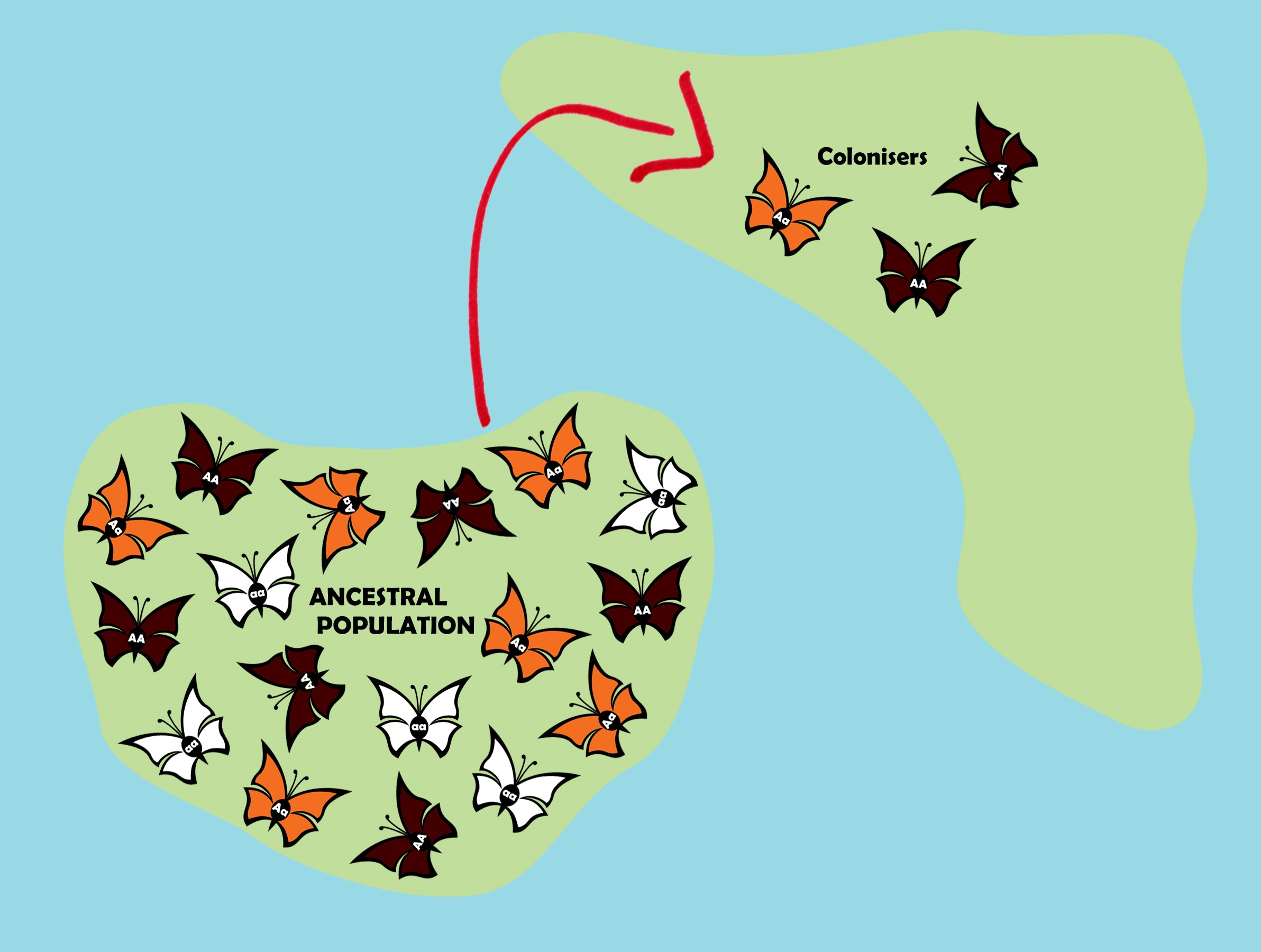
Hardy-Weinberg Equilibrium
in populations with stable allele frequencies (are not evolving), they may live in an unchanging environment without the selective pressures that lead to evolution
hardy and weinberg developed equations that describe the stable populations if they fit all of the given conditions:
- large population size: reduces the chances of genetic drift occurring
- random mating: eliminates the possibility of changing allele frequencies caused by sexual selection
- no gene flow: for allele frequencies to be stable, the individuals must not be entering or leaving the population; introduction of new individuals or movement of individuals out the population could change allele frequencies
- no selection: all phenotypes in the population must have the equal reproductive success to keep the allele frequencies stable (an advantageous phenotype would become more prevalent in the population)
- no mutations: would change the allele frequency of the population, as mutations are rare and random occurrences
if the conditions are met, then the follow equations can be used:
- p + q = 1
- used to describe allele frequencies
- p: frequency of dominant allele (A)
- q: frequency of recessive allele (a)
- p^2 + 2pq + q^2 = 1
- used to describe genotype frequencies
- p^2: frequency of homozygous dominant type (AA)
- 2pq: frequency of heterozygous genotype (Aa)
- q^2: frequency of homozygous recessive type (aa)
- if asked for allele frequency: find p or q
- if asked for genotypic frequency or number of individuals: find p^2, 2pq, or q^2
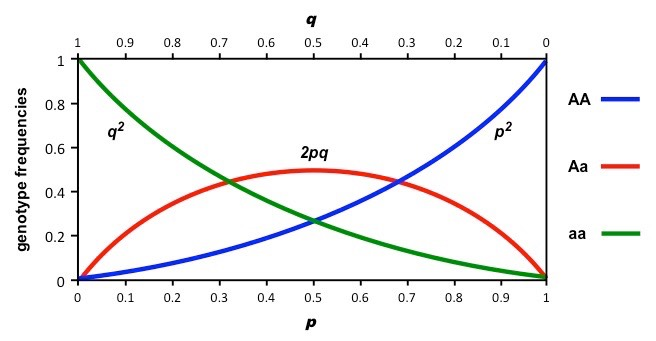
Phylogeny, Speciation, and Extinction
Phylogeny and Common Ancestry
phylogeny: history of the evolution of a species or group; shows lines of ancestry, common descent, and relationships between groups of organisms
- phylogenetic trees and cladograms: visual representations of hypotheses about the history of evolutionary events; used to create morphological evidence from fossils and time estimates from molecular clocks
- molecular clocks: changes in dna and protein sequences over time; information from them is generally considered more accurate than morphological characteristics because molecular data is less influenced by convergent evolution or external geographical events
shared derived characteristics: found in a group of organisms (called a clade) that set them apart from other groups of organisms
- they indicate homology between organisms in a clade and are evidence of common ancestry
nodes: part of phylogenetic tree that represents common ancestry; the more recent the common ancestor, the more related any given two organisms are
- outgroup: the least-related member of the tree
- root: the common ancestor of all the tree members
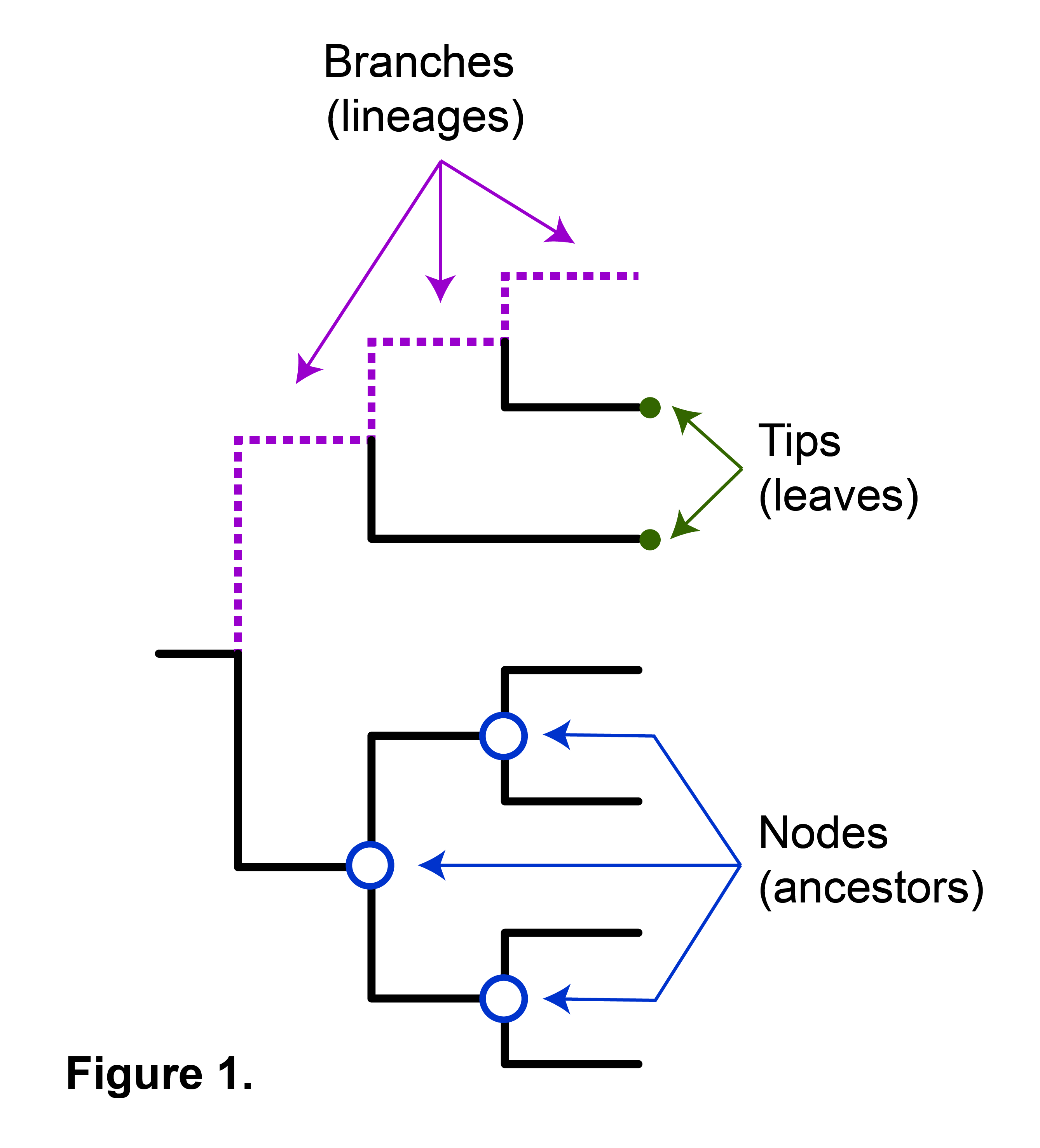
speciation: formation of new species
extinction events: death of all members of a given species
LUCA: last universal common ancestor; estimated to be from approx. 3.5 billion years ago
theories of how life originated on earth:
- inorganic materials that were present in earth’s early day atmosphere combined to make building blocks of macromolecules
- supported by evidence from miller-urey experiment ( in which a model of earth’s early atmosphere was constructed in a lab; after a few weeks amino acids and other biological macromolecules were found)
- meteorites may have transported organic molecules (that are needed for life) to earth
- supported by evidence from murchison meteorite (found in australia 1969) which contained sugars and over 70 different amino acids
evidence for common ancestry in all eukaryotes on earth:
- membrane-bound organelles in all eukaryotes
- linear chromosomes in all eukaryotes
- all eukaryotes contain genes with introns
- none of these characteristics are in prokaryotes, indicating common ancestry only between eukaryotes
Speciation
species: group of organisms that are capable of interbreeding and producing viable and fertile offspring
speciation: evolution of new species; occurs when two populations are reproductively isolated from each other; rates of speciation can vary
- reproductive isolation prevents interbreeding, which results in evolution of new species (along with causes by environmental factors)
adaptive radiation: sometimes caused by speciation; the evolution of organisms into separate species due to the occupation of different ecological niches
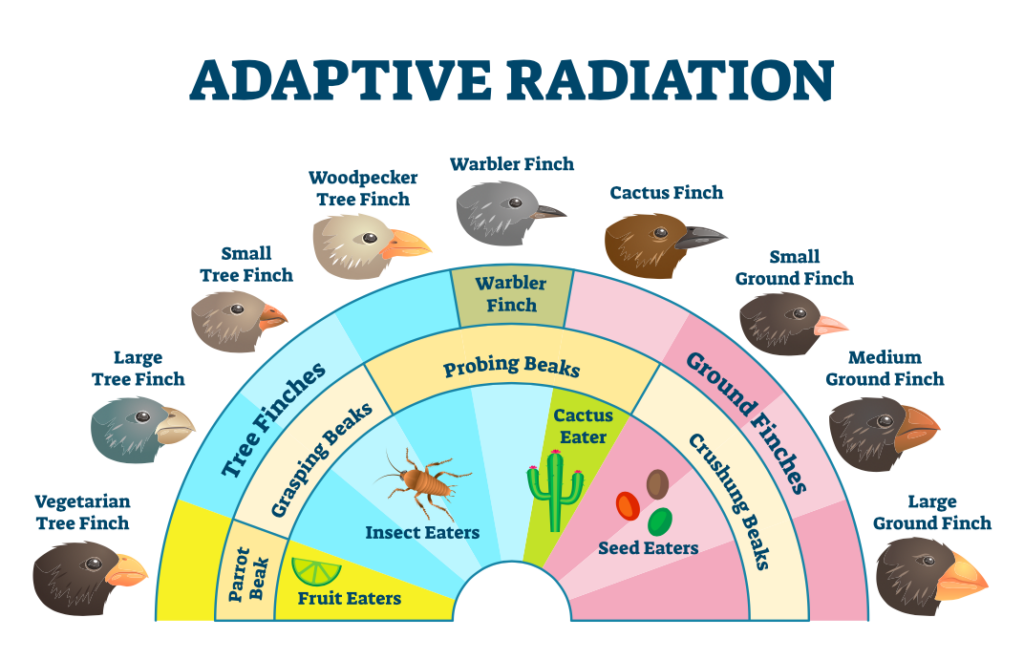
gradualism: the low and constant pace of speciation; occurs when an environment is more stable with less selective pressures on the population
punctuated equilibrium: long periods of stability in a species interrupted by periods of rapid evolution; occurs when rapid changes to the environment occur and lead to speciation
- usually caused by natural disasters (ex. volcanic eruption, rapid climate change, asteroid, etc.)

speciation can be allopatric or sympatric:
- allopatric: a larger population becomes geographically separated; smaller subgroups diverge and become separate species over time
- sympatric: occurs in the same geographic area, but other factors lead to reproductive barriers between members of the group
- polyploidy: mechanism of sympatric speciation; replication of extra set of chromosomes (most often occurs in plants)
- polyploidy plants can’t breed with regular plants, so they become a separate species over time
- sexual selection in animals can lead to sympatric speciation
reproductive barriers: lead to speciation by preventing interbreeding somehow; can be pre-zygotic or post-zygotic
pre-zygotic barriers: pre-zygotic barriers: prevent formation of zygote (fertilized egg)
- habitat isolation: organisms live in different habitats and do not come in contact with each other for interbreeding to occur
- temporal isolation: organisms live in the same habitat, but have different breeding seasons that do not allow interbreeding to occur
- behavioral isolation: some organisms only breed with species that exhibit compatible mating behaviors (ex. mating calls, dances, etc.); prevents interbreeding between less compatible individuals
- mechanical isolation: the reproductive organs of organisms are located in incompatible spots on their bodies, preventing the mating process from occurring correctly
- gametic isolation: despite organisms being able to mate, the gametes are still incompatible so no zygote is produced
post-zygotic barriers: occur after zygote is formed; prevent the zygote from developing into viable and fertile adult organism
- reduced hybrid viability: two organisms can produce a zygote, but it doesn’t live into adulthood, keeping them reproductively isolated
- reduced hybrid fertility: two organisms can produce a zygote, but it is sterile and cannot continue another generation of the new species
- hybrid breakdown: the a viable and fertile zygote can be formed in the first generation, but the subsequent generations produce weaker and less fit organisms that lead to the extinction of the species after a few generations
Extinction
- extinction: the death of all members of a species
- the level of genetic variation in a population can affect the population’s ability to survive in changing environmental conditions
- more genetically diverse populations are more likely to withstand the environmental changes
- ecological stresses (created by human activity) increase extinction rates
- examples: habitat destruction, overhunting, etc.
- species diversity depends on a balance between rates of speciation and extinction
- if more species are going extinct than being formed, species diversity will decrease
- extinction can have negative consequences, but it can also clear available habitats and niches for other species